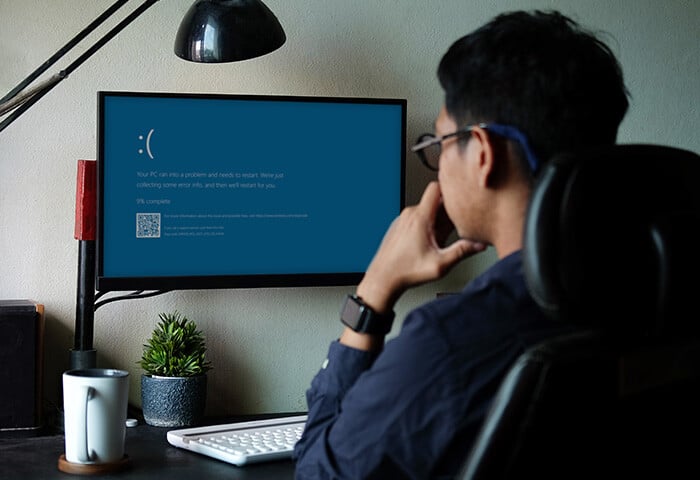What is Windows Modules Installer?
Windows Modules Installer Worker (also known as Windows Modules Installer, WMIW, or TiWorker.exe) is a core system process in Windows that checks for the latest Microsoft updates and installs them automatically. WMIW is a package installer that keeps core processes patched and current, and installs new features and security updates as they become available.
Windows Modules Installer Worker can tie up significant system resources, but it’s necessary to keep Windows’s essential processes, like the .NET Framework, running smoothly. Although the installer has been known to cause performance problems while in use, your high CPU usage might not be Windows Module Installer’s fault. If your machine seems overworked, test your PC for performance and battery issues and learn how to fix high CPU usage or fix an overheating computer.
You can also help Windows Modules Installer do its job efficiently by improving boot times and speeding up your internet connection so your computer can download update files faster.
Why does Windows Module Installer Worker cause high disk use?
Every time your PC installs a new update or a new version of Windows (such as 22H2 for Windows 10), Windows Module Installer Worker updates all your Windows files and backs up old data. It’s a massive operation that requires a considerable amount of processing power and space.
If you’re seeing TiWorker.exe or Windows Modules Installer Worker causing high disk usage in Windows 10 or 11, or high CPU usage, your computer should calm down after Windows Modules Installer finishes the update. If you’re experiencing extremely high CPU usage or high disk usage long after the updates are done, you might have a problem
Consistently high disk usage could be a sign that your hard drive needs to be repaired. See how to use CHKDSK on Windows to check your hard drive’s health. High CPU use is normal when stress-testing your CPU, but abnormal in most other circumstances. Frequent high CPU usage can even result in the dreaded Windows black screen. And if you’ve overclocked your CPU, you may also notice high CPU temperatures.
Before diving into fixing Windows Modules Installer issues, check out our guide to fixing 100% CPU usage in Windows. Also, consider physically cleaning your computer and fixing loud computer fans to improve speed and performance.
How can I fix high CPU usage of Windows Modules Installer?
If you’re suffering from nonstop high CPU or disk usage from Windows Modules Installer Worker or TiWorker.exe, then it’s time you looked closer. Here’s how to stop Windows Modules Installer Updates from burning through your CPU and disk capacity.
Solution 1: Set Windows Installer Startup to Manual
When Windows Modules Installer Worker updates automatically, it can suddenly commandeer your system and disrupt workflow. Setting Windows Installer Startup to manual allows you to get important updates at your convenience, or when you have the resources to spare. Windows will still notify you when there's an update available.
Here’s how to set Windows Installer Startup to Manual:
-
Press Win + R to open Run, then type services.msc and press Enter.

-
Scroll to Windows Module Installer. Right-click and select Properties.

-
Under Startup Type, select Manual and click Apply.

Windows Installer Startup should now be set to Manual. If TiWorker.exe and Windows Modules Installer are still causing high disk usage or high CPU usage, you can try ending the TiWorker.exe process through Task Manager.
Note: The solutions here are for Windows 11. The steps for fixing TiWorker.exe high cpu usage in Windows 10 may be slightly different.
Solution 2: End the TiWorker.exe process
Sometimes it’s best to quit TiWorker.exe and start again. You can also look for other programs that may be competing with Windows Modules Installer Worker or TiWorker.exe for your computer’s valuable resources. For example, svchost.exe is also known to cause high CPU usage — resolve it, and you’ll give TiWorker.exe more power to work with.
Here’s how to end the TiWorker.exe process:
-
Press Ctrl + Shift + Esc to open Task Manager. Click the Details tab.

-
Scroll to TiWorker.exe, right-click, and select End task to end all related processes.

Solution 3: Delete the SoftwareDistribution folder
The SoftwareDistribution folder temporarily stores files needed for Windows updates. Sometimes, the files stored in SoftwareDistribution conflict with new updates, causing Windows Module Installer Worker to have high CPU usage.
Keep in mind that deleting the SoftwareDistribution folder removes your Windows update history. The next time you update Windows it’ll take longer since Windows will have to redownload everything you removed.
Here’s how to delete the SoftwareDistribution folder:
-
Press Win + R together to open Run. Type services.msc and hit Enter.

-
Scroll to Windows Update and click it. In the left panel, click Stop the service.

-
Press Win + R to open Run again. Type C:\Windows\ and press Enter.

-
Scroll to SoftwareDistribution and right-click it. Select Delete.

The SoftwareDistribution folder will now be removed, including old temporary Windows Update files that might have been causing Windows Module Installer Worker to result in high disk or high CPU usage.
While you’re at it, clean other temporary files from your computer that might be getting in the way of Windows Module Installer, too. If your high CPU usage persists, run the Windows Update Troubleshooter.
Solution 4: Run Windows Update Troubleshooter
Windows Update Troubleshooter can repair certain issues with the Windows Module Installer Worker itself. Windows Update Troubleshooter is simple to use, but it can’t resolve more complicated issues with WMIW.
-
Press Win + S together to open Search. Type troubleshoot and select Troubleshoot settings.

-
Select Other troubleshooters.

-
Next to Windows Update, select Run.

Try updating Windows again after the Troubleshooter completes to see if it fixed the Windows Update errors.
Solution 5: Run System File Checker (SFC scan)
You might have corrupt Windows update files, or other corrupt files, jamming up Windows Modules Installer Worker and causing it to overwork your CPU. Running the System File Checker can repair corrupt files automatically so the Windows Modules Installer can work the way it needs to.
Here’s how to run a system file checker (SFC scan) on Windows 11:
-
Press Win + S together to open Search and type command prompt. Then right-click the Command Prompt result and select Run as administrator.

-
Type sfc /scannow and press Enter (note the space between sfc and /scannow).

Windows will now scan and replace system files. This process can take up to 15 minutes to complete, and it may require a restart. If the scan finds errors, you can also repair corrupted Windows system files with DISM.
Solution 6: Disable Windows Update
Disabling Windows Update is not recommended, as it makes Microsoft unable to deliver the latest security patches and leaves you vulnerable to security exploits until you enable it again. This solution is best used temporarily, and only if you re-enable it as soon as possible.
Here’s how to disable Windows Update temporarily:
-
Press Win + R to open Run. Type services.msc and press Enter.

-
Scroll to Windows Module Installer and right-click it. Select Properties.

-
Under Startup Type, select Disabled. Click Apply.

Windows Update should now disable Windows Modules Installer temporarily. We recommend re-enabling the program as soon as possible — some of the most damaging cyberattacks in history, like Wannacry ransomware, were able to spread because of Windows users who neglected to keep their systems updated.
Solution 7: Install cleanup software
One of the best ways to keep your PC running smoothly is to use cleanup software that updates your favorite programs automatically and runs 24/7 maintenance to keep your PC humming. AVG TuneUp does all that, plus it optimizes your CPU usage by putting memory-hogging programs to sleep and clears out junk files taking up too much disk space. Try it free today.
Reduce CPU and disk usage with AVG TuneUp
A lagging computer can easily reach 100% CPU or disk usage, especially if it’s full of unnecessary programs. AVG TuneUp streamlines your PC on multiple fronts to ensure that you have enough CPU power and disk space to run the apps you need.

Our PC optimization suite automatically scans your computer to detect and get rid of unneeded apps and junk files, removing bloatware and other junk in a single click. And its patented Sleep Mode settings helps prevent apps from hogging CPU resources with unwanted background activity.
Try AVG TuneUp for free today and discover just how fast your computer can be.
FAQs
Can I turn off Windows Modules Installer?
Yes. you can turn off Windows Modules Installer, but we don’t recommend because your computer won’t get important software updates while it’s disabled. To ensure your computer gets critical security updates automatically, keep WMIW turned on.
Is Windows Module Installer or TiWorker.exe a virus?
No, neither Windows Module Installer nor TiWorker.exe are computer viruses. Far from being harmful or malicious software, they’re both core Windows tools that are essential for your operating system to work smoothly. Windows includes several preventative measures to ensure that a virus can’t easily pretend to be an existing Windows service.
How to permanently disable Windows Module Installer Worker?
You can disable Windows Module Installer by ending TiWorker.exe in Task Manager, but it will start again after a reboot. We do not recommend disabling Windows Module Installer, because of the critical security patches that software updates deliver, but it is possible and could be warranted in extreme circumstances.
To disable Windows Module Installer Worker:
-
Open Task Manager > Services tab.
-
Click Open Services.
-
Right-click Windows Module Installer and select Properties.
-
Under Startup Type, select Disabled, then click Apply.
What causes 100% disk usage?
100% disk usage is often caused by a failing hard drive, or a hard drive that is struggling to read and write. Excessive background tasks, malware, or too much downloaded material can also cause 100% disk usage. Uninstall programs you don’t use, then read how to get rid of a virus or other malware on your computer and 12 ways to fix 100% disk usage.
If you’re still at 100% disk usage, consider switching to an SSD (solid state drive), which is typically faster and more efficient than a HDD (hard disk drive). SSDs can usually handle Windows input/output requirements better than HDDs. Review our comparison of SSDs vs HDDs to see if an upgrade is in order.
Is it OK to delete installer files from Windows?
It’s not OK to delete installer files from C:\Windows\Installer. Important files are saved in this folder that help programs and applications run. If you delete all the installer files, your applications and programs may cease to function altogether. Instead, try reducing the size of installer files by cleaning up the WinSxS folder.
How can I see what is running on my PC?
Here are a few ways to see what's running on your PC:
-
Open Task Manager > Processes tab. Task Manager shows all the foreground and background processes currently running on your PC.
-
Run Command Prompt as an administrator, type in tasklist and hit Enter.
-
Open Windows Powershell and type in Get-Process.






















/AVG-How-to-clear-cache-on-your-Mac-Thumb.jpg)





%20and%20how%20to%20remove%20them%20(Signal)/Signal-What-is-a-PUP-Thumb.jpg)
/Signal-The-best-cleaning-software-for-Mac-Thumb.jpg)



